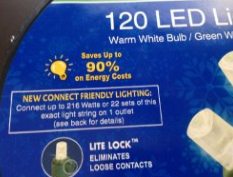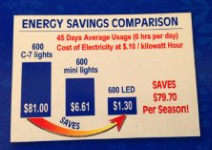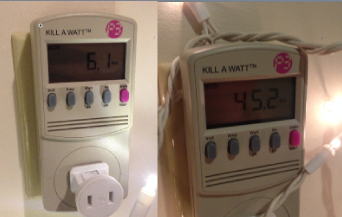We’ve covered the Insteon 8-watt light bulb, a DIY project involving LED light strips, and the Kill A Watt to quickly view energy usage (without needing a whole-house system). Armed with the knowledge that LED lights are cheaper to run and the ability to measure the difference, I noticed the following bold claims on a strand of LED Christmas lights I recently bought:


Specifically, can you really save $80 per season by just switching over to LED Christmas lights? I ran a little test with two runs of Christmas lights having roughly the same number of lights on them – one with the “regular” lights and one with LEDs:

Aside from the LEDs being brighter (they’re the ones on the left), the Kill A Watt shows an LED power savings of 86% over the incandescent strand – pretty close to the 90% claim on the package!

Now, about the claim you’re going to save $80 per season? Turns out that’s a little more disingenuous because they’re comparing apples and oranges. The label makes it clear that the calculation is based on 5 strands of lights being run for 45 days at 6 hours per day, or 270 total hours. I don’t know anyone who puts Christmas lights out in the middle of November to get 45 days of use out of them, but I know others who run their lights all night, so we’ll just accept these numbers for the purpose of this review. With my test sample, 5 strands would consume roughly 225 watts for incandescent vs. 30 watts for LED, or 2.25 cents/hour versus .3 cents/hr per hour. Multiply by 270 total hours and the seasonal cost of the 5 strands would be $5.40 and 72 cents, respectively. Those numbers are pretty close to what they are showing in their comparison of “mini” vs. “LED” lights, but the $80/year? What the hell are C-7 lights anyway? I looked it up – they’re these giant things. In other words, lights that aren’t even close to being equivalent and are used for some completely different purpose.
So, yes, for each strand of mini incandescent lights you swap out with LEDs
, you’ll save about a buck per year – which can add up with many strands. But the $80 per season you’re going to save? Unlikely, since the larger bulbs are used in different places than these mini lights.


